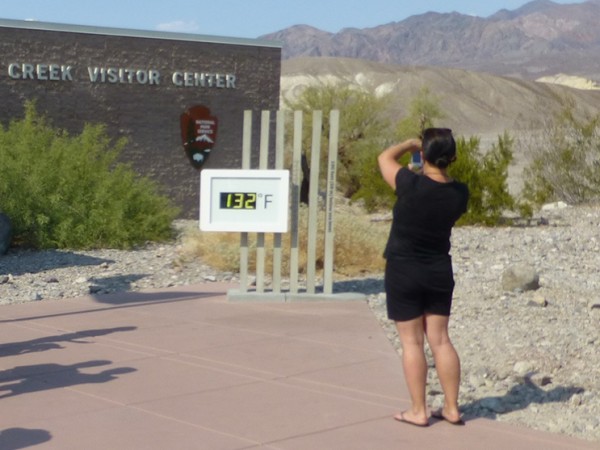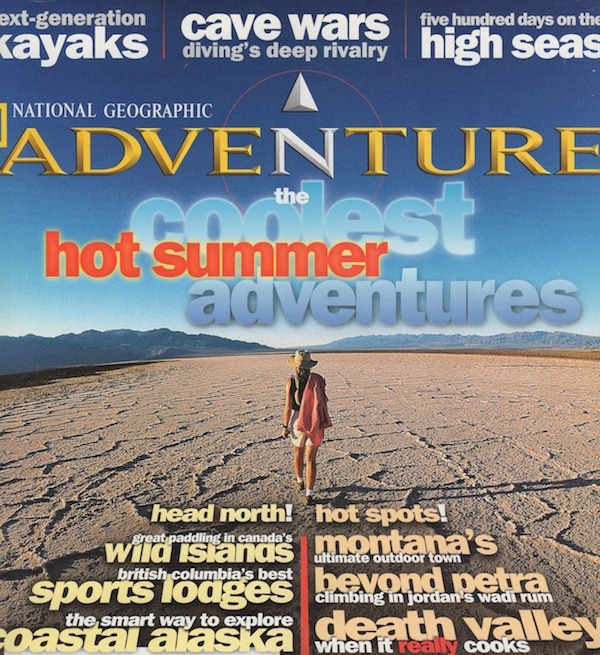Warning: I’m about to make a case for visiting Death Valley in the summer. But it’s clearly not for everyone. Extreme heat poses serious challenges. It requires constant hydration and maintining elecrolyte levels—i.e., drinking a lot of fluids and eating salty snacks. Ideally, one should only venture outdoors early in the morning and late in the day. Don’t drive or hike into the backcountry. Stay close to your car and to paved roads. If you’re not particularly curious about experiencing temperatures north of 120, I won’t blame you for moving on. There’s plenty more to read on this-here blog. But if you’re wondering why on earth the summer months in Death Valley draw many more visitors than the seemingly sane fall and winter months, read on.
Find Out How Hot HOT Is
I love weather: storm cells, huge snow dumps, massively wet tropical downpours. I’m a native of the Mojave Desert, but I’d never been hotter than a tepid 113 or so. I wanted to know what hot really felt like. So I did what curious writers have been doing for more than a century: I got National Geographic to pay my way on an apparently bizarre adventure. On assignment for National Geographic Adventure magazine, I took on Death Valley in August, and I hit pay dirt: It was really hot. It hit 126 the day I hiked across the salt pan at Badwater, at which time I knew that I had to be the hottest fool on the face of the earth.
So what does 126 feel like? Something like a hot blow dryer aimed at your face. Or like when you open the oven to baste a turkey and get that initial searing blast that makes your eyes squint. Only in Death Valley, the sensation lasts. But I just kept hydrated by drawing constantly on my Camelbak lifeline, walked slowly, never ventured too far from the car, and I mean this: I really enjoyed the experience.

It’s not actually quite as hot as it appears here. The thermometer was improperly calibrated, and it’s “only” 129! NPS Photo
Meet People from All Over the World
Americans go to London, Paris, and Rome. Europeans visit the Grand Canyon, Death Valley, and Yosemite. A little factor like 50-degrees Celsius temperatures won’t dissuade them from savoring the Death Valley leg of this must-do itinerary. When I’ve gone on pre-dawn patrol at Zabriskie Point, where more than 100 visitors typically await the rising of the sun, I rarely hear a word of English amid the quiet, expectant chatter. Most come from Germany, France, and Italy, with strong contingents from Asia and almost everywhere else. Except the US.
I once met a couple from Belgium who explained the fascination this way: “Nowhere in Europe do we have your vastness or the geographical extremes you have in America, or the temperature extreme of Death Valley. It’s like your basketball players: They’re 20 feet tall. All this creates a great fascination for us.”
Experience the Park at its Most Authentic
I often say that Death Valley is geology laid bare, carved open, and presented in all its exposed glory right before your eyes. There’s something about summer that suits its vivid geology. I like venturing into slots like Titus Canyon or Golden Canyon when visible waves of heat shimmer over the striated rock surfaces. I imagine prospectors and borax miners doing the same. I have a deep appreciation for the kind of drive and perseverance that characterized the early hearty denizens of Death Valley.
Now, if spring wildflowers seem plenty authentic to you, I understand. Visit in March. The park is glorious. Click here for more about the seasons in Death Valley.
Cool Off in the High Country
That, of course, is what the native Timbisha Shoshone people did. You didn’t see them wandering out onto the salt pan in the middle of August. Summer is a great time to venture up Emigrant Canyon Road to the Wildrose area, where the Charcoal Kilns are arrayed in cool, pinyon-scented air. (Yes, of course the Just Ahead app directs you up there.) It’s a great time to hike Wildrose or Telescope Peak for the most jaw-dropping possible views of Death Valley. If you have high clearance, you can camp at Thorndike or Mahogany Flat, and from your mountain perch, gaze down on silly fools like me tramping around Badwater. It’s 75 degrees where you are, 115 where I am, and we’re both having a blast.
Do the Resort Thing in the Heat of the Day
Furnace Creek Ranch, the park’s biggest lodge, is not only open all summer, it’s often booked solid. For that reason, Furnace Creek Inn, the Ranch’s tonier cousin, has a special open period from mid-July to late August. Food service is limited to a nightly buffet, but you can trundle down to the Ranch for other meals. Both places have spring-fed swimming pools. The Ranch also has the Borax Museum and a general store, and if you’re seeking bragging rights, you can get out at dawn and play golf on the world’s lowest golf course.
By the way, all of the park’s other lodges are open all summer too. Click here for our suggestions on where to stay.
Do the Visitor Center Thing in the Heat of the Day
Next door to Furnace Creek Resort is the Furnace Creek Visitor Center, where you can check the current temperature on the outdoor thermometer before spending time enjoying the high-tech exhibits and chatting with rangers and adventurous souls from all over the world. In air-conditioned comfort, of course.
See Scotty’s Castle
Sure, you can see it other times of year, but it’s open all summer, so why not? Be sure to check at the visitor center for tour times.
See Some Really Cool New Cars
The reason your car does so well in the summer heat of Death Valley . . . the reason it can pull tough grades without sending the thermostat soaring over its redline . . . is because car makers test their cars under really tough conditions. Death Valley is one of their favorite venues. You’re almost certain to see caravans of test cars navigating the park’s roads, as test drivers and engineers put the newest models to extreme tests.
Experience the Dunes at Night
The Mesquite Flat Sand Dunes are no fun in the heat of day, but head out there after dinner and you can stargaze or moon gaze in utter silence, and you might see a kit fox skitter across the sand. It might still be 100 degrees out, but it’ll feel cool. Sort of.
Chalk Up Bragging Rights
I’m constantly making hay from my Death Valley summer visits. Whenever the thermometer hits triple digits in civilization, I counter the requisite grousing with “This is nothing. I’ve been to Death Valley in the summer.” Which of course confirms any doubts about my good sense, but people do enjoy asking intelligent questions about my fascinating revelation. They usually begin with: “Why?”
To see our complete Death Valley Trip Planner series, click here.

